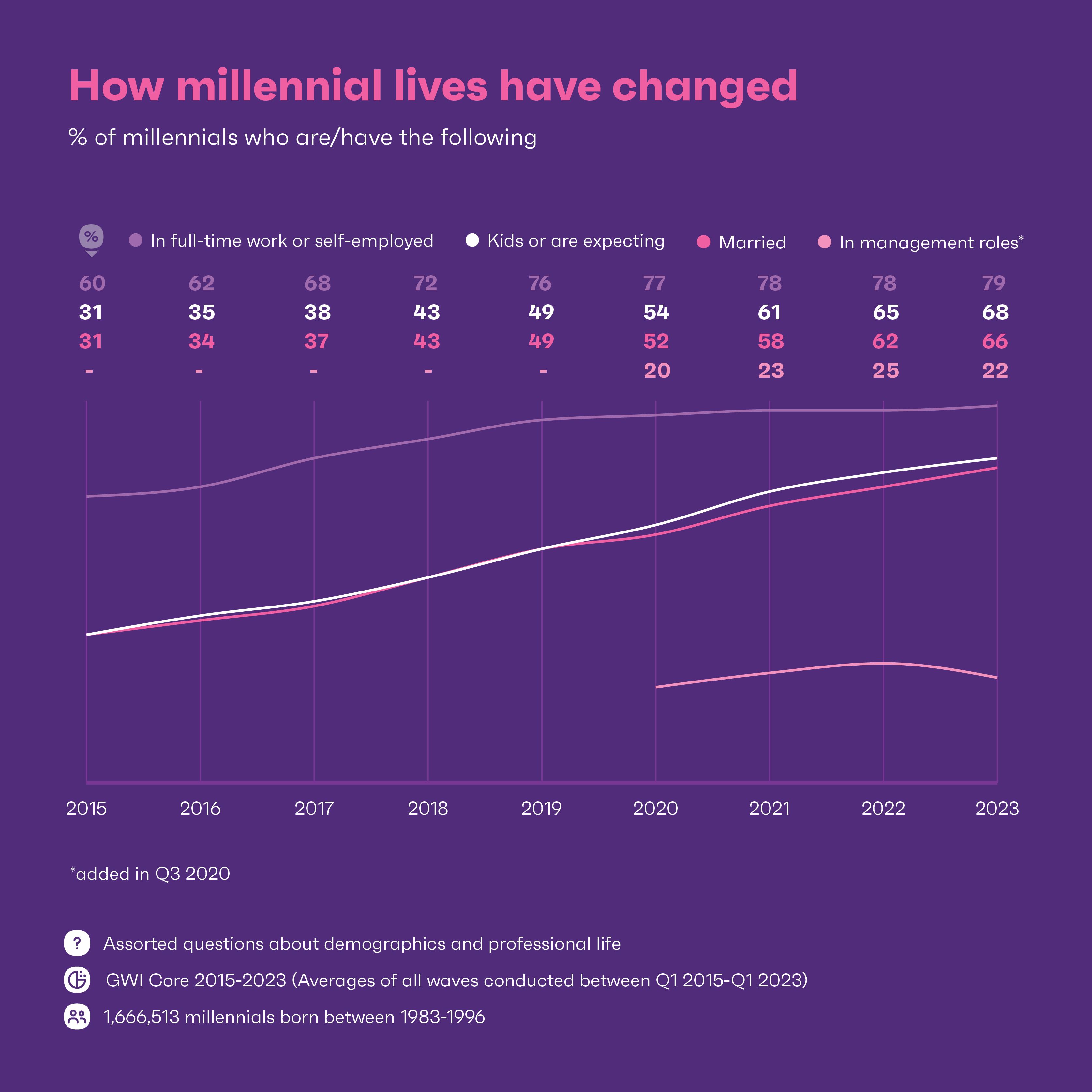Now that millennials are officially part of the 40s club, it’s time to take stock of what’s going on in their lives. They’re buying houses, settling down, and starting families – putting them into contact with certain businesses for the first time.
Armed with insights from our latest millennials report, we take a deep dive into millennial marketing statistics that reflect the biggest trends concerning this generation today, and answer the following questions:
- How are their priorities changing?
- What do millennials’ media habits look like in 2023?
- How do millennials feel about AI?
- Do they still respond to influencer marketing?
- What do brands need to know when engaging with millennials?
2023 millennial marketing stats
1. The number of US millennials who say raising a family is important has risen by 13% since 2020
Millennials are growing up. Aged between 27-40, they’ve got responsibilities and priorities that set them apart from their younger counterparts; the number of millennials who are married or are parents/expecting a child has more than doubled since 2015.

They’re making waves in the working world too. Over 3 in 4 are in full-time employment – a 32% increase since 2015 – while the number who work in executive, senior, or management roles has grown 8% since 2020.
That’s a lot to think about, and it’s impacted the way they see the world – and themselves. Take, for example, the growing importance of raising a family among American millennials; which displaced the more personal goal of “staying fit” in Q4 2021.
Globally, millennials have fallen behind Gen Z for saying being successful is important to them, and are more concerned with spending time with their family instead (65% say this). Subtle changes that reveal how their lifestyles are maturing.
This makes a lot of sense in context. A generation that’s been shaped by their share of financial hardships, millennials might be looking at family life as a distraction; a safe space from the unpredictable world they grew up in. Brands need to remember this, and think about how to speak to these newfound values.
2. Millennials are spending 48 minutes less online per day compared to 2017
The increase in time spent with family could be having another impact. While millennials were among the first to use social media, their time spent using it every day is falling.
Millennials are turning away from the digital world. Their priorities are moving offline as they place more value in physical experiences – no doubt a side effect of the post-pandemic landscape.
That’s not to say they’re ditching social media entirely; they still spend 2 hours 34 minutes using it every day, just second behind Gen Z (2 hours 51 minutes). It is, however, a staunch reminder that social media (like all forms of media) sit firmly in contention with each other, and other activities.
There’s increasing competition for millennials’ attention, at a time where their priorities are moving offline. Post-pandemic, they’re focusing more on real-world goals. When comparing their lives now to 2019, 77% of millennials say they’re more conscious about their health and wellbeing, and 61% are more likely to be seeking out new hobbies.
Brands should recognize the motivations behind millennials’ break from digital platforms, by doubling down on their desire for balance and wellness; promoting self-care and fostering genuine connections.
3. Millennials are the most likely generation to use AI daily in the workplace
There have been many recent controversies around AI-generated art, with musicians, writers, and illustrators being some of the most-affected.
But the millennial perspective on this issue is more liberal than average. The stats show millennials are the most likely generation to be interested in using it, and the same can be said for using it instead of a traditional search engine.
Almost 4 in 5 millennial ChatGPT users would consistently use ChatGPT over a search engine to help answer questions.
They trust AI tools too. Millennials are 10% more likely than the average in 11 markets to say AI tools should be able to imitate human art/music, or use copyrighted material, without legal concerns. In fact, many see AI as a workplace ally. They’re 10% less likely than average to say that AI will put jobs at risk, and are 12% more likely than average to believe they’ll allow employees to save time on tasks.
There are still some concerns, however. Millennial ChatGPT users are 47% more likely than Gen Z to think that the tool is not reliable enough to be used consistently, and big supporters of regulation – something the EU is ramping up.
So, to maximize opportunities, brands hoping to engage with this generation should look to implement AI tools where they can.
4. 80% of millennials trust influencers, only slightly behind Gen Z
As early users of social media, millennials were some of the first consumers to be exposed to influencer marketing. They’re very receptive to these individuals as a result – 80% trust them (to any extent), and they’re 15% more likely than the average consumer to trust them completely.

That’s good news for brands actively seeking partnerships with influencers, but there’s still some hurdles to take into account. De-influencing, where creators advise against buying certain products or cheaper alternatives has made recent headlines.
With the backlash against overconsumption, growing financial pressures, and ever-growing need for genuine recommendations, millennials want authenticity from the individuals they follow. De-influencing is still influencing, but it showcases how tastes have changed.
Brands wanting to capitalize on influencers should just be wary about selecting the right partners. As more markets step up their measures to address misinformation, it’s vital for brands to find the right fit and ensure any partnership aligns with their brand values.
5. Over half of millennials want brands to be reliable – their number one priority
When it comes to engaging with millennials, reliability is front of mind. During times of economic crisis, this is more important than ever since consumers want more bang for their buck.
And if a company is reliable, this can increase customer loyalty – particularly as far as millennials are concerned.
Almost half are loyal to brands they like, and a further 46% say they would advocate a brand online if they provide high-quality products.
This is important; brands who take these wants seriously can create valuable advocates at a time when trust is crucial.

There’s not just one factor consumers consider when making a purchase, especially in the midst of a financial crisis. A useful stat to highlight here is that over 4 in 10 millennials want brands to be innovative, smart and authentic. Nail as many of these qualities as possible, and brands will better their chances at engaging with millennials now, and for the long term.
Why stop with the purchase though? Brands can reinforce reliability further by supporting long after they buy a product. Millennials are 10% more likely than average to cite a live-chat feature as a purchase driver, and the number one thing they expect from brands is to listen to feedback. By being on hand with methods like live-chats, they can interact with customers and prove that they are there for them when they need them.
The next chapter…
Throw away the misconception that millennials are still ungrateful teenagers – they’re much older than you think, so it’s time to take a different approach.
Millennials are branching out into new stages of their lives, putting them on a collision course with new brands and services. They’re becoming more family focused and taking time away from screens to focus on other activities. If the fight for their attention wasn’t already difficult enough, it just got a whole lot harder, so brands need to think about how their changing lifestyles open up new avenues of engaging with them.
Report: Meet the millennials
Get your copy




.webp?width=495&height=317&name=pink_thumb_graphs%20(1).webp)
.webp?width=495&height=317&name=pink_thumb_letter%20(2).webp)
